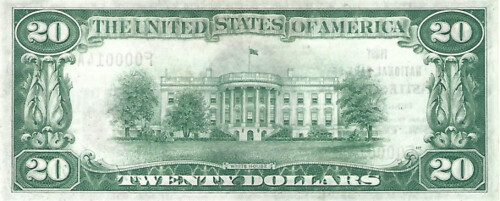
PREV ARTICLE
NEXT ARTICLE
FULL ISSUE
PREV FULL ISSUE
THE CASTLE SHANNON BANK ROBBERY
An interesting National Currency note was discussed in an article by Jennie K. Brown & Ray O'Shinski in the May 2016 issue of The
Clarion, published by the Pennsylvania Association of Numismatists. Editor Rich Jewell kindly provided the text and images for this
excerpt. Thanks! A version of the article also appeared in the ANA's Numismatist. -Editor


On May 14, 1917, one of the most notorious crimes in Pennsylvania's history occurred in a small, inconspicuous town on the west side of the state. It was an otherwise run-of- the- mill day in Castle Shannon when five Russian immigrants entered the town's First National Bank and began demanding money. A hold-up and shoot-down ensued, and after multiple shots were fired and cashiers and crooks alike fell, the remaining gunmen stormed into the cage to loot the bank in over $18,000 in coins and cash. Of that, only over $8000 has been accounted for to this day. This robbery and the events that occurred on that spring afternoon would go down in Pennsylvania history as one of the most notorious crimes ever committed. Twelve years after that murderous day in Castle Shannon, after the infamous Stock Market Crash of 1929 and well into the Great Depression, the U.S. Treasury called in all currency to be accounted. They took a census, and while most banks brought in one to two thousand dollars, a mere $250 in Castle Shannon notes was accounted for - $250 out of the possible $108,000. Everybody was looking for the Castle Shannon money, but nobody was finding it. All US banks closed in 1933; in that year all banks came under the Federal Reserve Bank System we know today. Tracing the Note
The First National Bank of Castle Shannon printed $108,550 dollars worth of national currency, which is a small output to begin with. Because of this, National bank notes from Castle Shannon in general are scarce. The bank opened in 1908 and ceased the printing of notes in 1932 – a small 24-year printing period. In 1902, The First National Bank of Castle Shannon printed 1,047 sheets of $20 blue seal national bank notes adorning the portrait of United States' Treasury Secretary Hugh McCulloch with the blue seal indicating a limited note form. Twenty-seven years later, another printing of Castle Shannon $20 notes began, but this time, only 51 sheets were printed. By nature, $20 notes are three times more rare over smaller bills, so when Ray purchased the extremely uncommon 1929 note, he knew it was something extraordinary. “It's the 14th note,” he says. Notes were printed on sheets of 6 per, so Ray owns the second note on the third sheet of printed $20 notes. Rare doesn't even begin to describe it. “I have people offering up to $15,000,” he says. On that “note”, the elusiveness surrounding the Castle Shannon Bank Robbery coupled with the uniqueness of Castle Shannon notes in general makes Ray's $20 piece one of the most collectable pieces in Allegheny County, if not in the entire state of Pennsylvania.
Great note! I grew up in Western Pennsylvania and was always fascinated with the name of that town. Why "Castle Shannon"? Where
was the castle? There was no internet in those days and I wasn't curious enough to go to a library and find out. But I asked Dr.
Google and found this on the Castle Shannon Borough web site. -Editor
The people who colonized Southwestern Pennsylvania were mostly of Scotch-Irish decent and the area that became Castle Shannon was no exception. Land patents to established boundaries were first issued in 1784 and it was stylish to name ones property. Some of these patent names showed religious inclination, as in "Jerusalem" and "Gilead"; the others incorporated the owners name as in "Cool Castle" and Hulse's Walk," David Strawbridge commemorated his Irish roots by naming his farm "Castle Shanahan." David Strawbridge's farm was mostly along what is currently Poplar Avenue to Castle Shannon Boulevard, then up to Shady Run. He died in 1792, with no male heirs, so his property was left to his only unmarried daughter, Jean. She sold the parcels of the original patent to her sister's families. At first this area was claimed by both Pennsylvania and Virginia, so each of the founders established their claim by petition whichever state was more convenient. The greater area became known as Lower St. Clair of Washington County, and then was repositioned into Allegheny County in 1797. The local citizens petitioned for years to break away from Lower St. Clair and in 1844 Baldwin Township was formed. Baldwin contained most of the South Hills. With different areas developing their own characteristics by the 1870's this area had become know as the Village of Castle Shannon. To read the complete article, see:
For more information on the Pennsylvania Association of Numismatists, see:
THE BOOK BAZARREWayne Homren, Editor The Numismatic Bibliomania Society is a non-profit organization promoting numismatic literature. See our web site at coinbooks.org. To submit items for publication in The E-Sylum, write to the Editor at this address: whomren@gmail.com To subscribe go to: https://my.binhost.com/lists/listinfo/esylum All Rights Reserved. NBS Home Page Contact the NBS webmaster 
|